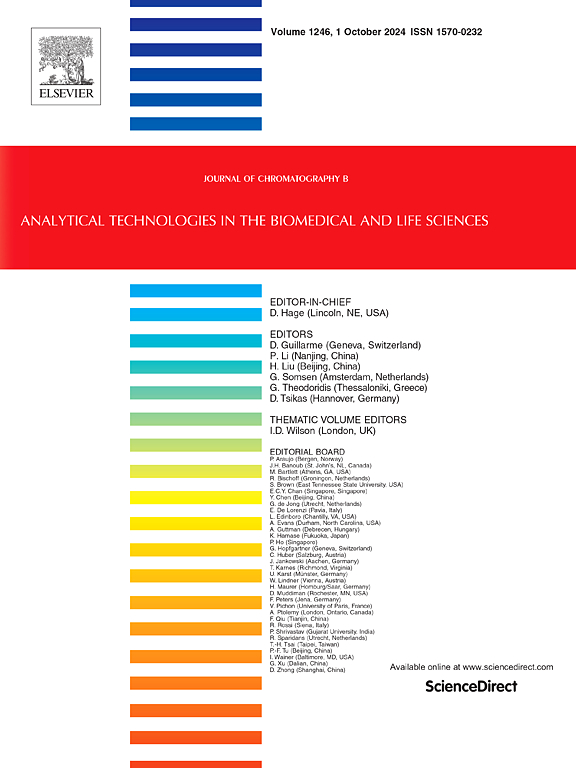超高效液相色谱-质谱/质谱法定量测定体积计量干血斑中的 18 种常见滥用药物和代谢物,包括四氢大麻酚和羟基四氢大麻酚:一种可持续的微创采样方法
IF 2.8
3区 医学
Q2 BIOCHEMICAL RESEARCH METHODS
引用次数: 0
摘要
滥用药物的使用日益增多,促使法医毒理学家开发快速、简单、微创的生物液体采样技术,并结合确保结果准确的分析方法。为此,我们开发了一种方法,旨在定量检测 DBS 中的 18 种滥用药物和代谢物。通过在 Capitainer® B 卡上添加空白全血中的分析物,对该方法进行了验证。提取物采用目标 UHPLC-MS/MS 方法进行分析。安非他明、MDA、MDMA、甲基苯丙胺、可卡因、可待因、苯甲酰基可待因、古柯碱、吗啡、6-MAM、丁丙诺啡、美沙酮、EDDP、氯胺酮、去甲丁丙诺啡、四氢大麻酚和羟基四氢大麻酚的线性定标范围为 1-100 ng/mL。实验发现,除诺丁啡、四氢大麻酚和四氢大麻酚-OH 的检测限为 1 纳克/毫升外,所有分析物的检测限均为 0.5 纳克/毫升。日内和日间准确度令人满意,偏差率在 5%以内。对日内和日间精确度的评估显示,除乙二胺四乙酸二异丁酯外,所有化合物的 CV% 值均在 20% 以内。在低浓度(2 毫微克/毫升)和高浓度(75 毫微克/毫升)水平下计算的平均提取回收率为 63%,而在相同水平下测定的平均基质效应,除可待因(70%)和亚甲二氧基甲基苯丙胺(131%)外,所有分析物的回收率均在 85% - 115% 之间。该方法适用于点在 DBS 卡上的真实血样,最低检测值为 1.3 纳克/毫升。事实证明,HPLC-MS/MS 能够在 DBS 卡上获得的少量血液中鉴定出低浓度的所有目标分析物,而 DBS 卡又是一种有效且可持续的微型采样设备。本文章由计算机程序翻译,如有差异,请以英文原文为准。
Quantitative determination by UHPLC-MS/MS of 18 common drugs of abuse and metabolites, including THC and OH-THC, in volumetric dried blood spots: a sustainable method with minimally invasive sampling
The increased use of drugs of abuse urges forensic toxicologists to create quick, simple, minimally invasive sampling techniques for biological fluids combined with analytical methods assuring accurate results. To this purpose, a method was developed aimed at quantifying 18 drugs of abuse and metabolites in DBS. Validation of the method was conducted by spiking blank whole blood with the analytes on Capitainer® B cards. The extracts were analyzed by a targeted UHPLC-MS/MS method. Linear calibration was achieved in the range of 1–100 ng/mL for: amphetamine, MDA, MDMA, methamphetamine, cocaine, codeine, benzoylecgonine, cocaethylene, morphine, 6-MAM, buprenorphine, methadone, EDDP, ketamine, norbuprenorphine norketamine, THC, and OH-THC. Experimental LOD was found at 0.5 ng/mL for all analytes except for norbuprenorphine, THC and THC-OH which yielded a LOD of 1 ng/mL. Intra- and inter-day accuracy was satisfactory with bias% resulting within 5%. Evaluation of intra- and inter-day precision yielded CV% values within 20%, for all compounds except EDDP. Average extraction recovery calculated at low (2 ng/mL) and high (75 ng/mL) concentration levels was 63% while average matrix effect determined at the same levels was found to be within 85% − 115% for all analytes except from codeine (70%) and MDMA (131%). The method was applied to authentic blood samples spotted onto the DBS card and the minimum value detected was 1.3 ng/mL. HPLC-MS/MS proved capable to identify all the targeted analytes at low concentrations in the small blood volumes obtainable from DBS cards, which in turn confirmed to be effective and sustainable micro-sampling devices.
求助全文
通过发布文献求助,成功后即可免费获取论文全文。
去求助
来源期刊

Journal of Chromatography B
医学-分析化学
CiteScore
5.60
自引率
3.30%
发文量
306
审稿时长
44 days
期刊介绍:
The Journal of Chromatography B publishes papers on developments in separation science relevant to biology and biomedical research including both fundamental advances and applications. Analytical techniques which may be considered include the various facets of chromatography, electrophoresis and related methods, affinity and immunoaffinity-based methodologies, hyphenated and other multi-dimensional techniques, and microanalytical approaches. The journal also considers articles reporting developments in sample preparation, detection techniques including mass spectrometry, and data handling and analysis.
Developments related to preparative separations for the isolation and purification of components of biological systems may be published, including chromatographic and electrophoretic methods, affinity separations, field flow fractionation and other preparative approaches.
Applications to the analysis of biological systems and samples will be considered when the analytical science contains a significant element of novelty, e.g. a new approach to the separation of a compound, novel combination of analytical techniques, or significantly improved analytical performance.
 求助内容:
求助内容: 应助结果提醒方式:
应助结果提醒方式:


